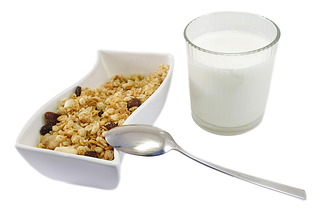This blog was written by Lisa Larkin. Meet our blogging fitness specialists at the NIFS website.
 It’s okay to eat breakfast food for dinner, but is it okay to eat non-breakfast foods in the morning? I don’t think it matters what you eat, as long as you eat something healthy to get the body and brain ready to start your day. Breakfast is the most skipped meal of the day, but the most important!
It’s okay to eat breakfast food for dinner, but is it okay to eat non-breakfast foods in the morning? I don’t think it matters what you eat, as long as you eat something healthy to get the body and brain ready to start your day. Breakfast is the most skipped meal of the day, but the most important!
Skipping Breakfast Makes You Gain Weight
Eating breakfast helps to control weight gain. Some people skip breakfast thinking it’s going to help them lose weight, but it could cause you to overeat later in the day. It is very important to at least eat some low-fat yogurt and fruit in the morning to get your metabolism started. Breakfast will also help you to concentrate better at work and help with memory.
Make Time for Breakfast
Another reason people skip breakfast is that they don’t have enough time in the morning. It’s better to get out of bed and have five extra minutes to eat breakfast than hitting the snooze button. Make something quick (for example, a piece of wheat toast with peanut butter) you can eat on the way out the door. Or, pack a few things for breakfast the night before to have it ready to go in the morning.
Try to avoid eating such a large dinner that you’re not hungry in the morning. Eating an earlier dinner and avoiding late-night snacks will help to increase your appetite in the mornings, and help to prevent weight gain. We all know preventing weight gain also protects you from heart disease and other health issues. So try it tomorrow morning: Eat a healthy breakfast to start your day!

 One of my favorite things to do in Indiana is to visit the various farmers’ markets around town. As a dietitian I am a sucker for the fresh fruits and veggies but I also love the homemade desserts, candles, pasta, kettle corn, fresh flowers, and other wonderful items you can find. Here are my top five reasons why visiting your local farmer’s market is a must.
One of my favorite things to do in Indiana is to visit the various farmers’ markets around town. As a dietitian I am a sucker for the fresh fruits and veggies but I also love the homemade desserts, candles, pasta, kettle corn, fresh flowers, and other wonderful items you can find. Here are my top five reasons why visiting your local farmer’s market is a must. How would you rate your oral health?
How would you rate your oral health? ROI and corporate wellness is, well, it's tricky. Don't believe me? Ask the experts. They’ll tell you that accurately calculating ROI can be done, but that it is very hard to do it the right way. What’s worse is that attempting to isolate ROI for a specific element of your company’s wellness strategy may prove even more elusive.
ROI and corporate wellness is, well, it's tricky. Don't believe me? Ask the experts. They’ll tell you that accurately calculating ROI can be done, but that it is very hard to do it the right way. What’s worse is that attempting to isolate ROI for a specific element of your company’s wellness strategy may prove even more elusive. Do you sometimes feel tired after work, but your children have plenty of energy to burn off? Do you find it difficult to find time for fitness and family life? Try combining them for a new, fun outlook on physical activity. You and your children will benefit! It helps them burn off energy and you will hopefully gain some energy.
Do you sometimes feel tired after work, but your children have plenty of energy to burn off? Do you find it difficult to find time for fitness and family life? Try combining them for a new, fun outlook on physical activity. You and your children will benefit! It helps them burn off energy and you will hopefully gain some energy.
 Fill the cart with many fresh fruits and vegetables. Fresh produce packs a healthy punch with vitamins, minerals, and antioxidants. Focus on color by rainbow shopping. Look for fruits and veggies that are green, yellow, red, purple, orange, and white in color. The more colors you purchase, the better.
Fill the cart with many fresh fruits and vegetables. Fresh produce packs a healthy punch with vitamins, minerals, and antioxidants. Focus on color by rainbow shopping. Look for fruits and veggies that are green, yellow, red, purple, orange, and white in color. The more colors you purchase, the better. r nutrition content, it won’t be long before the food on your child’s plate will be more colorful, more portion-conscious, and more nutritious than ever before. The changes brought forth by the
r nutrition content, it won’t be long before the food on your child’s plate will be more colorful, more portion-conscious, and more nutritious than ever before. The changes brought forth by the